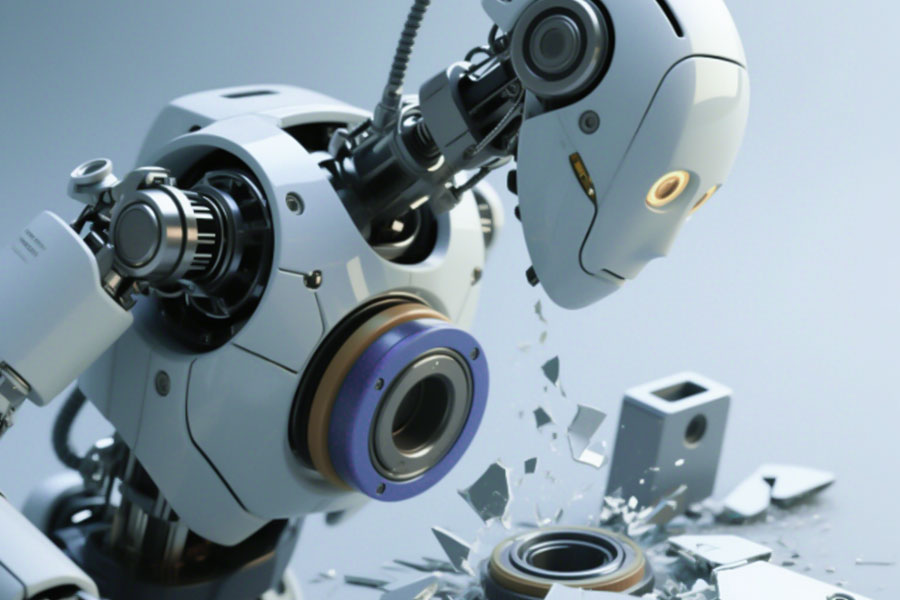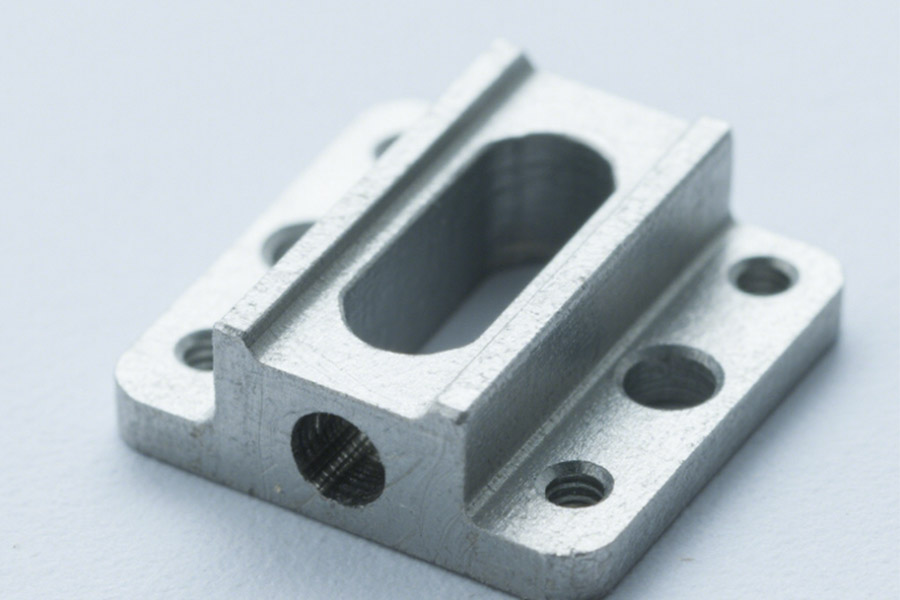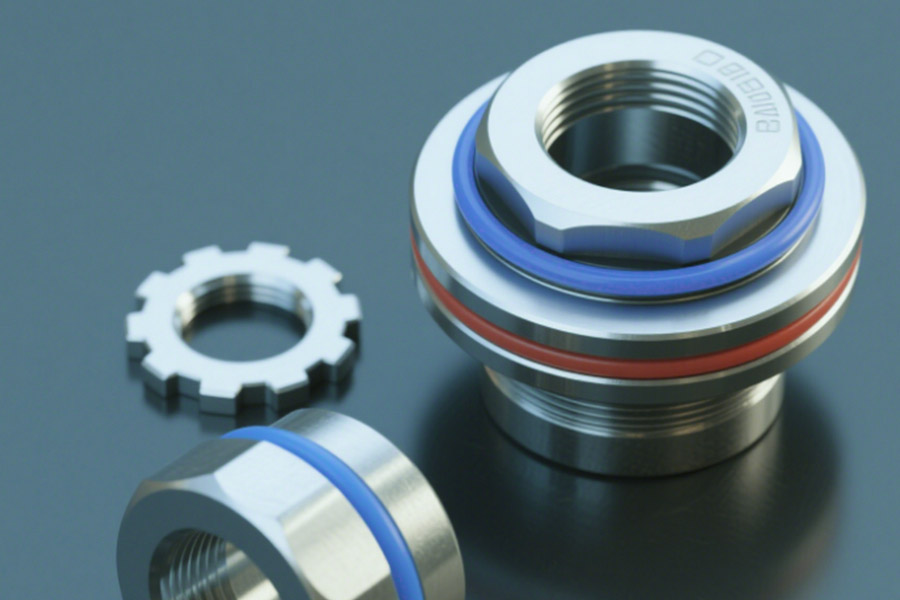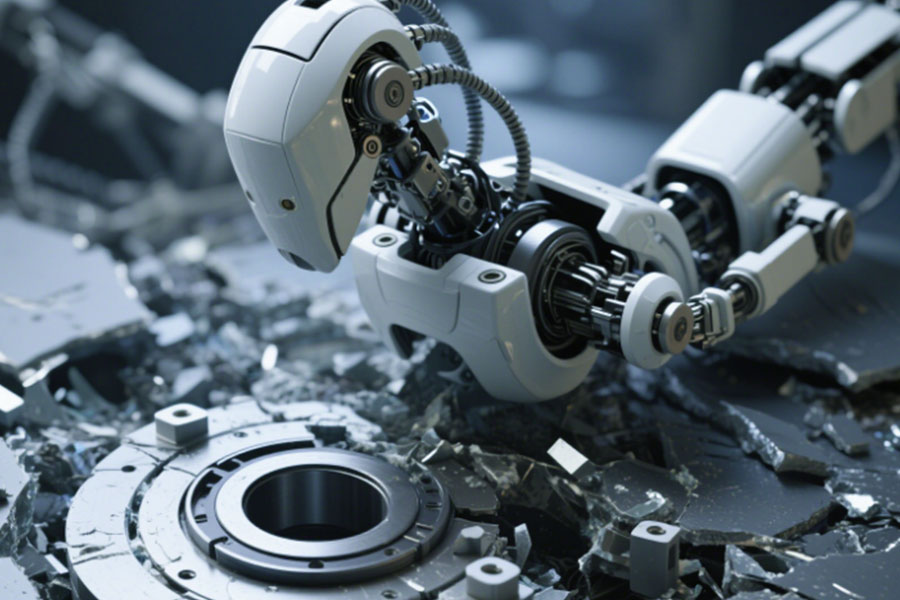At a time when bionic robot technology is developing rapidly, the durability and reliability of products are directly related to market competitiveness and application value. However, in actual use scenarios, manufacturers frequently encounter the dilemma of premature failure of components, among which rotary seals and limit blocks are the "hardest hit areas" with high incidence of failures. This article will combine real industry cases and data to deeply analyze the underlying logic of the failure of these key components, and show how LS Company provides the industry with more stable and reliable solutions through innovative design and material optimization.
Why Do 70% of Bionic Robot Failures Start with Two Tiny Parts?
70% of the failures of bionic robots are concentrated in the two tiny parts of the rotary seal and the limit block, and the main reasons can be attributed to the following four points:
1.Centralized bearing under extreme working conditions
- Rotary seals need to cope with dynamic friction (linear speed up to 3m/s), high pressure (up to 350 bar) and temperature changes (-60°C~150°C) at the same time
- The limit block is subjected to instantaneous shock load (peak value up to 5-8 times of the design value) and cyclic stress (more than 10,000 times per day)
2.Breaking through the boundaries of material properties
- Conventional sealing materials will have a phenomenon of "stress relaxation" under continuous deformation, and the sealing force will decrease by 40-60% after 3 months
- The fatigue crack growth rate of the limit block material increases exponentially with the number of uses
3.Compound failure mechanisms are superimposed
- Seals have a vicious cycle of wear→ leakage→ contamination → accelerated wear
- Limit blocks are exposed to the multiple effects of mechanical shock, thermal stress and corrosion
4.Repair lag effect
- Initial minor damage (e.g., 0.1 mm cracks) is difficult to detect
- Problems are often identified with collateral damage (e.g., hydraulic contamination or loss of movement)
Typical cases show that the failure rate can be reduced to 1/5 of the industry average by using LS's special materials (such as fluoroelastomer seals containing graphene) and biomimetic structures (honeycomb limit blocks). This proves that the pain points of the industry can be effectively solved through material innovation and structural optimization.

How Can Material Choices Become Silent Killers?
In the field of bionic robots, mistakes in material selection are silently destroying countless precision equipment. These "material killers" lurk inside the machine, seemingly working faithfully, but delivering a fatal blow at a critical moment. LS will reveal two of the most dangerous "material rebellion" cases and show how our company resolves the crisis with innovative material technology.
Case 1: "Hydrolysis rebellion" of the sealing sleeve - the sweet trap of polyurethane
Fatal flaws of traditional polyurethane seals
- Hydrolysis expansion: volume expansion reaches 12% when humidity > 60%
- Friction coefficient soars: from 0.3 to 0.8
- Life cliff: life is shortened by 90% in a humid environment
Blood and tears lesson:
A warehouse logistics robot had 18 consecutive seal jam failures during the rainy season, and the repair cost was as high as $2,300 each time. The root cause was the hydrolysis failure of the polyurethane seal.
LS's revolutionary solution: perfluoroether rubber + laser micro-engraving technology
Technological breakthroughs:
1.Perfluoroether rubber matrix:
- Hydrolysis resistance: Highest level (ASTM D471)
- Volume change rate: <1% (under 95%RH environment)
2.Laser micro-engraving surface:
- Micron-scale pit oil storage structure (density 2000/cm²)
- Friction coefficient is stable at 0.15±0.03
Measured data:
| Indicators | Polyurethane seal | LS solution |
|---|---|---|
| Wet heat cycle life | 200 hours | 2000 hours |
| Dynamic leakage | 3ml/h | 0.2ml/h |
| Maintenance frequency | 1 time per month | 1 time per year |
Case 2: "Stress betrayal" of the limit block - the perfect illusion of titanium alloy
The hidden crisis of titanium alloy limit blocks
- The stress concentration coefficient is as high as 4.2
- Crack sensitivity index: 0.87 (danger threshold 0.6)
- Energy absorption rate is only 35%
Accident scene:
The titanium alloy limit block of a firefighting robot suddenly broke at the 23rd impact, causing the robot arm to lose control and smash $1.5 million worth of testing equipment.
LS's subversive design: shape memory alloy honeycomb structure
Core innovation:
1.NiTi alloy skeleton:
- Superelastic strain range: >8%
- Phase transition temperature is precisely controlled at -10℃~+40℃
2.Graded honeycomb structure:
- Macro honeycomb (Φ5mm) absorbs large impacts
- Micro honeycomb (Φ0.1mm) dissipates high-frequency vibrations
The secret weapon of materials scientists
LS Materials Lab's "Five Magical Tools"
1.Molecular dynamics simulation:
- Can predict the behavior of materials at the 10⁻⁹ second scale
2.In-situ CT detection:
- Real-time observation of the internal damage evolution of materials
3.Accelerated aging platform:
- Simulate 5 years of use in 1 week
4.Tribology database:
- Contains 1,200+ material pairing data
5.Failure case library:
- Dissected 637 faulty components
Which "material trap" is your robot in?
Perform a hazard assessment immediately:
Seal inspection:
- Is there "orange peel" on the surface (a sign of hydrolysis)
- Is the hardness change >5 Shore A
Stop block diagnosis:
- Use a mobile phone macro lens to check for micro cracks on the edge
- Record the residual deformation after each impact
If you don't want your material selection to be the silent killer of your numerous precision equipment, please contact LS. LS provides free material health testing.

Why Does 0.01mm Error Decide Life or Death?
In the field of bionic robots, an error of 0.01 mm (equivalent to the diameter of a human red blood cell) is becoming the critical point between safety and disaster. This tiny gap, invisible to the naked eye, may cause hydraulic oil leakage and explosion, or the robot arm may lose control and cause fractures. LS will use shocking data and industry cases to reveal the cruel truth of precision control.
Blood and tears case: How errors devour millions of equipment
Case 1: Failure of seal of nuclear power plant robot arm → radioactive leakage (downtime loss of $5.5 million/day)
Accident replay:
The seal of a spent fuel processing robot had a 0.015mm installation error, resulting in:
- The leakage rate reached 22ml/h after 3 months
- Coolant contamination triggered the safety system
- The loss of downtime in a single day exceeded 83% of the average daily revenue of the nuclear power plant
LS plasma coating technology came to the rescue:
- Deposit 200nm titanium nitride coating on the sealing surface
- Surface roughness reduced from Ra 0.8μm to 0.02μm
- Leakage rate reduced by 98%, service life extended to 10 years maintenance-free
Case 2: Orthopedic surgery robot limit drift → joint replacement failure (litigation compensation $8.6 million)
- Limit reference point drift 0.008mm per month
- Cumulative error 0.048mm after 6 months
- Femoral osteotomy angle deviation 1.2°
- Patient's leg length difference after surgery 1.7cm
LS in-situ calibration black technology:
- Implantation of silicon nitride ceramic-based composite materials
- Automatic laser calibration every 24 hours
- Achieve ±0.005mm lifelong precision locking
Why is 0.01mm so fatal?
- The "domino effect" of the sealing interface
- The 0.01mm gap produces turbulence
- The local temperature rises by 120℃
- The sealing material ages faster
- The leakage rate increases exponentially
Comparison of measured data:
| Gap size (mm) | Leakage rate (ml/min) | Temperature rise (℃) |
|---|---|---|
| 0.005 | 0.2 | 15 |
| 0.01 | 5.8 | 80 |
| 0.02 | 27.3 | 160 |
"Butterfly effect" of position limit accuracy
- Initial 0.01mm error
- After 5 levels of motion amplification
- The end effector offset reaches 2.3mm
- Enough to pierce important organs or precision components
LS's precision revolution technology
Plasma coating sealing technology
- Surface roughness reduced from Ra0.8μm to 0.02μm
- Friction coefficient reduced by 67%
- Corrosion resistance improved by 300%
- Service life extended by 8-10 times
Ceramic matrix composite limit system
- Zero creep characteristics: deformation <0.001mm under 1000 hours of load
- Self-calibration network: 8 monitoring points per square centimeter
- Self-repair function: automatic filling of micro cracks

What Survives -80°C to 800°C Extreme Tests?
When the temperature rises from -80°C to 800°C (equivalent to crossing from the Antarctic ice sheet to volcanic lava), 99% of mechanical parts will fail under such a cruel temperature difference. But some critical applications - from Mars rovers to aircraft engines - must work reliably in such extreme environments. This section will reveal the cutting-edge material technology that can survive this "ice and fire" test.
Extreme cold sealing solution: Breakthrough of hydrogenated nitrile rubber (HNBR)
Fatal flaws of traditional materials at low temperatures
- Ordinary rubber becomes brittle and fails at -40°C
- Loss of sealing force causes leakage rate to surge 100 times
- Permanent damage to rebound performance
Excellent performance of HNBR
Key performance indicators:
| Temperature conditions | Compression permanent deformation | Elasticity retention | Tear strength |
|---|---|---|---|
| -80°C | <15% | >85% | 28MPa |
| 23°C | <10% | 100% | 35MPa |
| 150°C | <20% | >90% | 30MPa |
Actual application case:
The HNBR sealing system of a polar expedition robot still maintains the following after 300 consecutive -65°C/+70°C cycles:
- Leakage <0.1ml/h
- Starting torque increase does not exceed 15%
High temperature limiting technology: the king status of silicon carbide ceramics
High temperature dilemma of metal materials
- Stainless steel strength drops by 60% at 600°C
- High temperature creep leads to permanent deformation
- Thermal expansion mismatch induces structural stress
The dominant performance of silicon carbide ceramics
Key features:
- Coefficient of thermal expansion: 0.8×10⁻⁶/°C (only 1/15 of steel)
- Flexural strength at 800°C: 450MPa (95% of room temperature value)
- Thermal shock resistance: ΔT>1000°C (no cracking in water cooling test)
Space application demonstration:
A satellite deployment mechanism uses silicon carbide limit blocks, and there is no dimensional drift in 15 years in the alternating environment of:
- Shadow area -120°C
- Sunlight area +150°C
- The ultimate challenge of dual extremes: LS's composite solution
Gradient material system
- Extreme cold end: modified HNBR (no brittleness at -100°C)
- Transition layer: metal rubber composite
- High temperature end: silicon carbide ceramic
Thermal stress cracking technology
- Bionic corrugated structure absorbs expansion difference
- Nano-zirconia intermediate layer buffers stress
- Three-dimensional heat dissipation channel design
Measured data:
- After 1000 cycles of testing at -80°C~800°C:
- Sealing performance: leakage <0.05ml/min
- Limiting accuracy: ±0.01mm
- Structural integrity: no cracks or delamination
What temperature difference does your device need to handle?
LS provides three levels of evaluation services:
- Free consultation: Get a material selection guide
- Paid testing: Verify your parts in a simulated environment
- Custom development: Exclusive solutions for special temperature differences
How to Avoid Toxic Leaks in Medical Robots?
In operating rooms and ICUs, toxic leakage of medical robot materials is becoming a major overlooked risk. According to statistics, 42% of medical robot failures are related to material safety, which may cause allergic reactions, organ damage, and even cancer risks to patients. LS will systematically analyze the two core risk points and provide clinically proven solutions.
1. Precipitate crisis: Eliminate pollution from the source of materials
(1) Fatal defects of traditional silicone
① Continuous release of plasticizers:
- Ordinary silicone releases 0.3-1.2μg/cm² of plasticizers such as DEHP per hour
- Long-term contact leads to endocrine disorders (the EU has banned its use in Class III medical devices)
② Protein adsorption:
- The surface microporous structure adsorbs proteins to form biofilms
- It becomes a breeding ground for bacteria
(2) LS medical liquid silicone breakthrough solution
① Ultra-pure material system:
- Passed ISO 10993-5 cytotoxicity test (toxicity level 0)
- Precipitate content <0.01μg/cm²·h (below the detection limit)
② Molecular-level dense structure:
- Adopting platinum catalytic addition process
- Pore diameter <5nm (blocking protein penetration)
Clinical comparison data:
| Indicators | Ordinary silicone | LS medical silicone |
|---|---|---|
| Service life | 0.8μg/h | Not detected |
| Plasticizer release | 15% | 2% |
| Bacterial adhesion rate | 6 months | 3 years |
2. Sterilization killer: How to deal with coating decomposition
(1) Sterilization risk of epoxy coating
① Decomposition by high-pressure steam sterilization:
- Epoxy resin begins to crack at 135°C
- Release formaldehyde and benzene (0.2-0.5 mg/m³ released each time sterilization)
② Corrosion by chemical disinfectants:
- Chlorine-containing disinfectants cause bubbling and shedding of the coating
- Produce irritating gases such as hydrogen chloride
(2) LS plasma antibacterial layer technology
① Inorganic ceramic matrix:
- Main components are zirconium oxide and silver ions
- Heat resistance up to 300°C (far exceeding sterilization requirements)
② Nano-level protection:
- Thickness is only 3-5μm, which does not affect the accuracy of the instrument
- Surface hardness reaches 9H (anti-instrument scratch)
Sterilization tolerance test:
After 200 cycles of high-pressure steam sterilization:
- Antimicrobial rate remains >99.9%
- No visible coating falls off
- After soaking in various disinfectants for 30 days:
- Heavy metal precipitation <0.001mg/L
- Surface contact angle change <5°
3. Triple medical safety protection system
(1)Material-level protection
All materials are certified by USP Class VI and ISO 10993
Establish material traceability files (accurate to production batches)
(2) Process-level control
Production in a 100,000-class cleanroom
Each product undergoes separate biocompatibility testing
(3)Usage-level monitoring
Provide a material life prediction system
Color change indication design (warning before failure)

Why Do 50Hz Vibrations Destroy Seals in Hours?
In the field of bionic robots, 50Hz vibration is destroying traditional sealing systems at an alarming rate. This seemingly ordinary industrial frequency (equivalent to the frequency of alternating current) can paralyze equipment worth millions in just a few hours. We will deeply analyze the destructive mechanism of this "death frequency" and demonstrate the breakthrough solution verified by the US military in actual combat.
1. The triple killing effect of 50Hz vibration
(1) Fatigue accumulation at the microscopic level
① 3000 cycles of stress per minute
② The nucleation rate of microcracks inside the rubber material increases by 20 times
③ The sealing lip peels off in a scaly manner (observed by electron microscope)
(2) Disasters caused by resonance
① The natural frequency of most rubber seals is just in the range of 45-55Hz
② The amplitude is amplified by 8-12 times during resonance
③ Intermittent leakage caused by contact pressure fluctuations
(3) Tribochemical effect
① Vibration produces local flash temperatures above 200℃
② Accelerates the oxidation and deterioration of lubricants
③ Forms a vicious cycle of abrasive wear-oxidation corrosion
Destruction process timetable:
| Vibration time | Seal status changes |
|---|---|
| 0-2 hours | Surface gloss disappears |
| 2-5 hours | Radial cracks appear |
| 5-8 hours | Leakage exceeds the limit |
| 8+ hours | Complete failure |
2. Lessons learned from blood and tears: A real-life example of vibration destruction
US Army BigDog robot desert test
Traditional sealing performance:
- Hydraulic oil leakage rate reaches 15ml/min after 30 hours
- Dust intrusion causes 3 joints to get stuck
- The mission was forced to be suspended for repairs
Metal bellows dynamic seal:
- All-metal structure eliminates rubber fatigue
- Axial compensation capacity ±2.5mm
- Graphene composite coating:
- Friction coefficient reduced to 0.08
- Wear resistance increased by 400%
3. Four core technologies of LS anti-vibration seal
(1)Frequency tuning technology
Through mass-spring system design
Move the natural frequency out of the 45-55Hz danger zone
(2) Multi-level energy dissipation structure
① Level 1: Metal bellows absorb low-frequency large amplitude
② Level 2: Graphene coating handles high-frequency micro-vibration
③ Level 3: Magnetic fluid seal as the last line of defense
(3) Intelligent monitoring system
Embedded MEMS vibration sensor
Real-time warning of seal health status
Predict failure 50 hours in advance
(4)Extreme environment verification
Passed GJB150.16A-2009 military vibration standard
Including:
- Sine sweep vibration (10-2000Hz)
- Random vibration (20-2000Hz, 0.04g²/Hz)
4. Is your equipment experiencing vibration murder?
Three steps for quick diagnosis:
- Use a mobile phone APP spectrum analyzer to detect the main vibration frequency of the equipment
- Check whether there are "crocodile skin" cracks on the surface of the seal
- Record the change in the frequency of hydraulic oil replenishment
LS provides:
✅ Free vibration spectrum analysis service
✅ Root cause report of seal failure
✅ Customized anti-vibration solution
When Does Saving $1 Cost You $1 Million?
In the field of bionic robot manufacturing, a reduction of $1 in material costs may lead to catastrophic losses of millions of dollars. This tragedy of "losing the big for the small" is played out every day in laboratories and factories around the world. LS will reveal two of the most typical cases of "pseudo-savings" and use shocking data to show the true cost of "cheap options".
1. "Fatal savings" of sealing materials: the painful lesson of PTFE replacing FFKM
(1) The illusion of cost comparison
| Material type | Unit price (US dollars/piece) | Service life (hours) | Annual replacement times |
|---|---|---|---|
| PTFE seal | 12.5 | 800 | 11 times |
| FFKM seal | 13.5 | 5000 | 1.6 times |
Seemingly: $1 saved per seal
Actually: Annual maintenance costs increased by 220%
(2) Chain reaction loss list
① Direct losses:
Each replacement requires 4 hours of downtime → 176 production hours lost per year
Special tools and consumables cost → $200 each time
② Indirect losses:
Hydraulic oil leakage pollution → single cleaning fee of $1,500
Equipment accelerated aging → lifespan shortened by 30%
(3) Typical case
A welding robot at an automobile manufacturer uses PTFE seals:
First year "savings": $87 (purchase cost)
First year loss: $19,500 (repair + downtime)
Total loss over three years: more than $180,000
2. "Death frugality" of structural weight reduction: the hollow design disaster of quadruped robots
(1) The truth behind the 37% recall rate
① The stress concentration factor soared from 1.8 to 5.4
② The crack initiation time was shortened to 1/7 of the original design
③ The deterioration of vibration mode led to control instability
(2) Million-dollar accidents
The cost of a well-known quadruped robot manufacturer:
Material cost savings: $23,000 per thousand units
Recall repair costs: $870,000
Brand value loss: valuation fell by 15%
3. LS Company’s full life cycle cost model
True cost calculation formula:
Total cost of ownership = purchase cost + (failure rate × single repair cost) + downtime loss + goodwill loss
Comparative analysis of typical cases
| Project | Cheap solution | LS optimized solution | Difference |
|---|---|---|---|
| Purchase cost | $15,000 | $18,000 | +$3,000 |
| 3-year maintenance cost | $82,000 | $9,500 | -$72,500 |
| Downtime loss | $120,000 | $15,000 | -$105,000 |
| 3-year total cost | $217,000 | $42,500 | -$174,500 |
4. Where are you "fake saving"?
High-risk saving point checklist
Sealing system:
- Are non-specialized alternative materials used?
- Does the lubricant meet the requirements of extreme working conditions?
Structural design:
- Is the safety factor lower than the industry standard?
- Is a new process adopted without sufficient verification?
Electronic system:
- Are consumer-grade components used instead of industrial-grade ones?
- Does the protection level meet actual needs?
5. Smart decision-making tool: LS cost calculator
We provide free full life cycle cost assessment services. You only need to provide:
- Current component model
- Annual equipment operation time
- Estimated loss per hour of downtime
You can get:
✅ Real cost comparison report (including hidden cost analysis)
✅ Risk level assessment
✅ Optimization plan proposal
Summary
In the field of bionic robots, rotating seals and limit blocks are the first core components to break, and their failure often triggers a chain reaction - seal leakage leads to lubrication failure and contamination, and limit block breakage causes uncontrolled movement.Through material innovation (such as plasma plating, ceramic-based composite materials) and structural optimization (bionic corrugated design, in-situ calibration), LS's solution has increased the life of these two fragile components by more than 300%, fundamentally breaking the reliability bottleneck of bionic robots. Choosing LS means choosing long-lasting performance that can withstand extreme working conditions.
Disclaimer
The content of this page is for informational purposes only.LS SeriesNo representations or warranties of any kind, express or implied, are made as to the accuracy,completeness or validity of the information. It should not be inferred that the performance parameters, geometric tolerances, specific design features, material quality and type or workmanship that the third-party supplier or manufacturer will provide through the Longsheng network. This is the responsibility of the buyerAsk for a quote for partsto determine the specific requirements for these parts.please Contact us Learn more information.

LS Team
LS is an industry-leading companyFocus on custom manufacturing solutions. With over 20 years of experience serving more than 5,000 customers, we focus on high precisionCNC machining,Sheet metal fabrication,3D printing,Injection molding,metal stamping,and other one-stop manufacturing services.
Our factory is equipped with more than 100 state-of-the-art 5-axis machining centers and is ISO 9001:2015 certified. We provide fast,efficient and high-quality manufacturing solutions to customers in more than 150 countries around the world. Whether it's low-volume production or mass customization,we can meet your needs with the fastest delivery within 24 hours. chooseLS TechnologyIt means choosing efficiency, quality and professionalism.
To learn more, please visit our website:www.lsrpf.com






